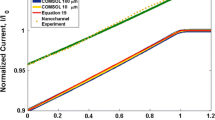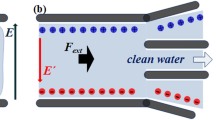Abstract
In this article, we investigate the effect of channel sidewalls on the transport of neutral samples through rectangular conduits under pressure-driven flow and small zeta potential conditions. Our analyses show that while these structures can significantly reduce the streaming potential in small aspect ratio rectangular channels, they introduce a very minor variation in the sample velocity with the extent of Debye layer overlap in the system. Moreover, the increase in sample dispersion due to the channel side-regions has been shown to be nearly independent of the Debye layer thickness and very comparable to that reported under simple pressure-driven flow conditions. Interestingly however, a simple one-dimensional (1D) model that decouples band broadening arising due to diffusional limitations across the depth and width of the rectangular conduit has been shown to capture the predicted dependence of the Taylor–Aris dispersion coefficient on the channel aspect ratio under all operating conditions with less than 3% error.



Similar content being viewed by others
References
Aris R (1956) On the dispersion of a solute in a fluid flowing through a tube. Proc R Soc A 235:67–77
Das S, Chakraborty S (2009) Influence of streaming potential on the transport and separation of charged spherical solutes in nanochannels subjected to particle-wall interactions. Langmuir 17:9863–9872
Dutta D (2007) Electroosmotic transport through rectangular channels with small zeta potentials. J Colloid Interface Sci 315:740–746
Dutta D (2008) Electrokinetic transport of charged samples through rectangular channels with small zeta potentials. Anal Chem 80:4723–4730
Dutta D, Ramachandran A, Leighton DT (2006) Effect of channel geometry on solute dispersion in pressure-driven microfluidic systems. Microfluid Nanofluid 2:275–290
Garcia AL, Ista LK, Petsev DN, O’Brien MJ, Bisong P, Mammoli AA, Brueck SRJ, Lopez GP (2005) Electrokinetic molecular separation in nanoscale fluidic channels. Lab Chip 5:1271–1276
Griffiths SK, Nilson RH (2006) Charged species transport, separation and dispersion in nanoscale channels: autogenous electric field-flow fractionation. Anal Chem 78:8134–8141
Napoli M, Eijkel JCT, Pennathur S (2010) Nanofluidic technology for biomolecule applications: a critical review. Lab Chip 10:957–985
Pennathur S, Santiago JG (2005) Electrokinetic transport in nanochannels. 2. Experiments. Anal Chem 77:6782–6789
Rice CL, Whitehead R (1965) Electrokinetic flow in a narrow cylindrical capillary. J Phys Chem 69:4017–4024
Schoch RB, Han JY, Renaud P (2008) Transport phenomena in nanofluidics. Rev Mod Phys 80:839–883
Taylor GI (1953) Dispersion of soluble matter in solvent flowing slowly through a tube. Proc R Soc A 219:186–203
van der Heyden FHJ, Bonthuis DJ, Stein D, Meyer C, Dekker C (2007) Power generation by pressure-driven transport of ions in nanofluidic channels. Nano Lett 7:1022–1025
Wang YC, Stevens AL, Han JY (2005) Million-fold preconcentration of proteins and peptides by nanofluidic filter. Anal Chem 77:4293–4299
Xuan XC (2008) Streaming potential effects on solute dispersion in nanochannels. Anal Chem 79:7928–7932
Xuan XC, Li DQ (2007) Solute separation in nanofluidic channel: pressure-driven or electric-field driven? Electrophoresis 28:627–634
Xuan XC, Sinton D (2007) Hydrodynamic dispersion of neutral solutes in nanochannels: the effect of streaming potential. Microfluid Nanofluid 3:723–728
Acknowledgment
This research study was supported by a National Science Foundation grant (CBET—0854179).
Author information
Authors and Affiliations
Corresponding author
Rights and permissions
About this article
Cite this article
Dutta, D. Solutal transport in rectangular nanochannels under pressure-driven flow conditions. Microfluid Nanofluid 10, 691–696 (2011). https://doi.org/10.1007/s10404-010-0701-5
Received:
Accepted:
Published:
Issue Date:
DOI: https://doi.org/10.1007/s10404-010-0701-5




